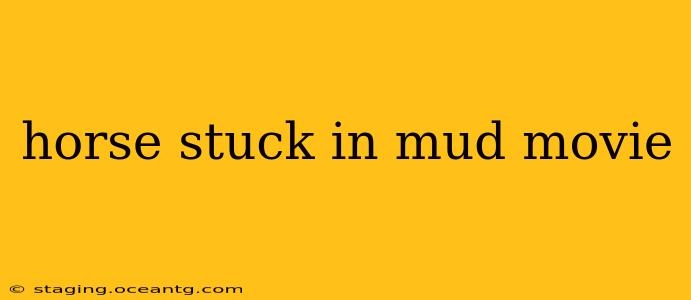The phrase "horse stuck in mud movie" evokes a potent image: a majestic creature struggling, the tension palpable. While no single movie centers solely on a horse stuck in mud as the main plot point, the scenario frequently appears as a compelling subplot or pivotal scene in various films, often highlighting themes of perseverance, human-animal bonds, and the power of community. This exploration delves into movies featuring this dramatic element, examining their portrayal and the underlying narrative significance.
What Movies Feature a Horse Stuck in Mud?
Pinpointing movies explicitly titled or predominantly focused on a horse trapped in mud proves difficult. The scenario acts more as a powerful visual metaphor or a crucial plot device. However, many films incorporate this scene, leveraging its inherent dramatic tension. Think of it as a microcosm of larger struggles—the horse's plight reflecting the protagonist's challenges. We'll explore examples where this scenario significantly impacts the narrative.
Many Westerns, for instance, utilize this type of scene. The arduous journey across challenging terrain often includes unexpected obstacles, and a horse becoming mired in mud naturally fits this narrative. While I cannot offer specific titles naming this precise scenario in the plot summary, searching for Westerns with challenging landscapes, particularly those focused on survival or arduous journeys, would likely uncover several examples.
How is the Horse Rescued in These Scenes?
The rescue itself forms a crucial part of the cinematic narrative, often showcasing the characters' resourcefulness, teamwork, and compassion. Several approaches are frequently depicted:
- Human Strength and Ingenuity: Characters often employ ropes, pulleys, and sheer muscle power to extract the horse. This emphasizes human resilience and the will to overcome adversity.
- Community Effort: A shared struggle strengthens bonds and highlights the importance of collaboration. The scene becomes a testament to community spirit, mirroring real-life situations where neighbors unite to tackle shared problems.
- Ingenious Tools and Techniques: Sometimes the rescue involves unique problem-solving. Maybe a nearby stream is diverted, or a makeshift ramp is constructed. This highlights inventiveness and adaptability in overcoming obstacles.
Why is the "Horse Stuck in Mud" Scene so Effective?
The visual imagery of a powerful animal struggling against the unforgiving mud creates a strong emotional response in viewers. This is amplified by several factors:
- Empathy for the Animal: Audiences connect with the horse's plight, evoking feelings of sympathy and concern. This emotional engagement anchors the viewer to the scene.
- Symbolic Resonance: The mud can symbolize various struggles, mirroring the characters' internal battles or external challenges. It serves as a potent visual metaphor.
- Dramatic Tension: The scene builds suspense as the audience anticipates the outcome, creating an engaging and emotionally charged sequence.
What are Some Common Themes Explored in Such Scenes?
The "horse stuck in mud" scenario usually serves to underscore larger thematic elements within the film:
- Perseverance: Both the horse and the characters demonstrate the ability to overcome obstacles.
- Human-Animal Bond: The scene highlights the strong connection between humans and animals, emphasizing the compassion and care shown in the rescue.
- Community and Cooperation: The collaborative effort often showcases the power of unity in tackling challenges.
- Facing Adversity: The scene becomes a microcosm of the larger narrative, representing the challenges the characters face throughout the film.
While a movie solely dedicated to a horse stuck in mud might be rare, the dramatic impact and symbolic potential of the scene make it a compelling cinematic trope, often serving as a powerful moment within a broader narrative. By analyzing its use across various genres, particularly Westerns and adventure films, one can appreciate its significance in storytelling.
